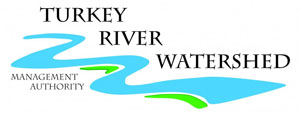Water Quality Monitoring on Nutting and Otter Creeks
By Rick Klann, Upper Iowa University
Submitted to the Fayette SWCD Report, February 2012
Upper Iowa University has completed three years of water quality monitoring on Nutting Creek as part of a Fayette SWCD project to improve the water quality in the watershed. Monitoring occurred from March through October. Samples were collected every other week from three sites along the creek.
Each sample was analyzed for the following physical and chemical parameters of water quality: temperature, pH, conductivity, dissolved oxygen and turbidity are measured on site; while samples returned to the lab are analyzed for suspended solids, fecal coliform bacteria, ammonia, total nitrogen and total phosphorus.
Twice a year (May and September), each site was sampled for benthic macroinvertebrates (primarily aquatic insects and other small organisms that live on the bottom). Since different species of benthic macroinvertebrates vary with respect to their ability to tolerate pollution, they can be very useful as indicators of water quality.
The biweekly sampling regime provides a snapshot of the water quality at a single point ill time: when the sample is collected. The benthic invertebrates, on the other hand, live in the stream year round and are thus exposed to water quality conditions throughout the entire year. Both approaches can provide valuable insight into the water quality of Nutting Creek.
The three years of monitoring indicate a definite trend of improving water quality. It appears that the efforts of this project to improve land-use practices within the watershed have had a positive effect. For example, low levels of dissolved oxygen can be a limiting factor for many living organisms. By year three of this project, levels of dissolved oxygen were consistently high enough such that this parameter is no longer negatively impacting the organisms occupying Nutting Creek. Typically, high levels of organic pollution (nitrogen and phosphorus) lead to low oxygen levels. Year three saw the lowest levels of phosphorus in Nutting Creek. Nitrogen levels, on the other hand, have yet to display much of a decline.
Another problem facing Nutting Creek is sediment washed into the creek via runoff. Throughout the life of this project, there has been a reduction in both the turbidity of the stream and the amount of suspended solids carried by the stream. These are additional indicators that the land-use projects implemented throughout the watershed are having a positive” impact.
As mentioned above, there has not been a significant reduction in the amount of nitrogen entering the stream. Another issue that remains is contamination of the stream with fecal coliform bacteria. Contributors of bacteria to the stream include livestock and septic systems. While there has been a reduction in the amount of bacteria in Nutting Creek, the numbers are still way too high to allow classification as a stream suitable for recreation involving primary contact with the water.
The benthic invertebrate data also support the contention that the water quality of Nutting Creek is improving. Proportionately speaking, we are seeing more mayflies and caddisflies in our samples (which have a lower tolerance for organic pollution) and fewer midges and blackflies (which have a higher tolerance). However, the overall diversity of benthic invertebrates in Nutting Creek is still fair1y low. Hopefully, improved water quality will allow for more species intolerant of pollution to colonize and establish viable populations in the creek, but this takes time.
My lab has also completed three years of monitoring the water quality of Otter Creek. This project was sponsored by Fayette SWCD and the city of West Union. Otter Creek is one of northeast Iowa’s trout streams. with trout being stocked at several locations downstream of West Union. The city, with the support of Fayette SWCD, has displayed interest in analyzing the contributions of runoff from the downtown area to Otter Creek.
One aspect of this project compares the water quality of runoff from downtown to the water quality of the stream above and below this input. In order to do so, samples were collected follOwing rain events of at least 0.5 inches.
In general, the runoff from downtown into Otter Creek does not have a huge impact on the water quality of the stream. The runoff is warmer (it picks up heat from concrete and pavement), and high water temperatures are one of the factors presenting the establishment of a reproducible population of trout in Otter Creek.
Typically, the runoff from downtown does not contribute much in the way of suspended solids to Otter Creek, with the exception occurring in 2011 when there was major construction downtown. The runoff from downtown can contain high levels of chloride, but rarely. are these levels high enough to impact the chloride levels in Otter Creek.
Usually, the amount of fecal coliform bacteria in the runoff from downtown is much less than that in Otter Creek. However, in 2011, the runoff carried significantly higher loads of bacteria, probably due to the major construction impacting sewer lines and old septic systems.
A comparison of the benthic invertebrate populations inhabiting the stream above and below the input of the runoff from downtown finds these two sites to be remarkably similar. This provides further support for the contention that the runoff from downtown West Union does not have a major impact on the water quality of Otter Creek. Not surprising, levels of phosphorus and nitrogen are lower in the runoff, and dissolved oxygen levels of pollution due to phosphorus and nitrogen (and the lower levels of dissolved oxygen that accompany these pollutants). The fact that the benthic invertebrate community is relatively unchanged from upstream of the runoff input to downstream of this point indicates that the runoff from downtown is not negatively impacting this community.
